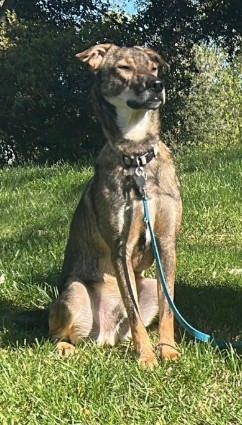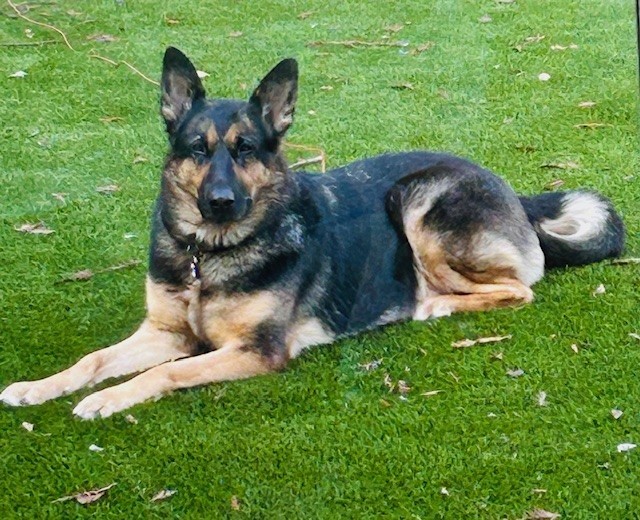When You Bring Your New Dog Home
What you will need and what to expect when you bring your new dog home from Golden State German Shepherd Rescue.
Your dog will have a flat collar and Rescue ID tag, which should remain on the dog at all times. Your dog will be microchipped but you may want to add an ID tag too with your name and phone number engraved on it. The dog can slip out of the flat collar if s/he pulls back, so bring a leash hooked to a chain, pinch (prong), Martingale collar or a Gentle Leader type head harness to use when you walk the dog. Head halters or pinch (prong) collars should have a chain backup as some dogs can slip a head a harness and pinch collars can break open.
Consider bringing a crate that is the correct size for your dog so that s/he can travel home in that. Your dog may be anxious leaving its foster home, or it may get sick on its way home and the crate will make the ride or subsequent clean up go easier.
Make sure to have adequate sized food and water bowls, at least one for food and a separate one for water. Stainless steel is often preferred due to ease of complete cleaning and lack of leaching of plastic by-products into the food or water. Feed a high quality dog food that is made by a dedicated manufacturer. If you plan to switch dog foods you should switch over gradually as many German Shepherds Dogs have sensitive stomachs and react negatively to food changes.
Bloat, the buildup of air, fluid, and/or in the stomach and/or Volvulus (stomach torsion), can be serious health issues for German Shepherds. Always keep a product with simethicone (e.g., Mylanta Gas (not regular Mylanta), Phazyme, Gas-X, etc.) on hand to treat gas symptoms. Some recommend giving dogs one of these products immediately if they seem in discomfort of the type mentioned in this bloat symptoms article while calling your vet immediately. Some people report they get faster/better results using Phazyme® Quick Dissolve 125 mg chewable tablets using about five tablets per dose. It is best to discuss this option with your vet ahead of time so before you ever need to use it. If your dog cannot get this down he is too far gone to try this remedy and should be rushed to the emergency vet.
You'll need some basic grooming tools and shampoo. Since German Shepherd Dogs can have sensitive skin purchase your shampoo accordingly.
For the sake of your new dog, your home, and your other pets, we highly recommend that you use an adequate size crate while your dog is adjusting to its new home. There is more information on Crate Training on our Training Articles page. There are two main kinds of crates: non-collapsible hard plastic or collapsible wire crate. Either is fine. Wire ones are easier to move around. A crate cover or a large beach size towel can be used to cover it to make it more den-like. Use old sheets, towels or similar as a bed inside the crate for the first week or so. Once you know the dog will not destroy the bedding you can use a washable crate pad.
Baby gates or exercise pens may be useful to keep your dog confined to a certain area such as the kitchen. Some dogs may find it easy to jump over them which is why a crate, after your dog is crate trained, or roofed kennel may be the best option to safely contain your dog.
You may also find dog beds are useful in locations such as the living room or where your dog is going to sleep at night.
Most German Shepherd Dogs like to chew, so a stash of safe chew toys will help keep your dog from hunting up inappropriate ones. Wolf-sized Nylabones or hard rubber Kong toys can be a good choice. Rubber items, rope toys, fleece toys, tennis balls or similar that can be chewed into small pieces and swallowed can cause blockages so should only be used under supervision. Edible bones/toys such as Greenies can cause stomach issues for some dogs. Tennis balls can wear down teeth. German Shepherds can choke on any ball smaller than a tennis ball, and some can choke on a tennis ball or similar sized ball.
Realize that you are going to have to completely supervise your dog until s/he proves to you that s/he has good behavior in all the situations your lifestyle requires. Using the crate when you cannot supervise your dog, and/or tying your dog to your waist or a piece of furniture so it remains in your vicinity can be useful ways to provide adequate supervision. Do not leave your dog alone in its crate longer than is recommended, which varies by age and health needs.
You can find additional information on training resources, including a list of trainers in your area, and health information in our resources and education section.


